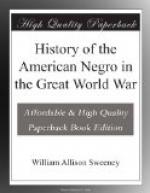“The mulatto lifted his arms against Captain Preston, and having turned one of the muskets, he seized the bayonet with his left hand, as if he intended to execute his threat At this moment, confused cries were heard: ‘The wretches dare not fire!’ Firing succeeds. Attucks is slain. Other discharges follow. Three were killed, five severely wounded and several others slightly.”
Attucks was killed by Montgomery, one of Captain Preston’s soldiers. He had been foremost in resisting and was first slain. As proof of a front engagement, he received two balls, one in each breast. The white men killed with Attucks were Samuel Maverick, Samuel Gray and Jonas Caldwell.
John Adams, afterwards President of the United States, was counsel for the soldiers in the investigation which followed. He admitted that Attucks appeared to have been the hero of the occasion and the leader of the people. Attucks and Caldwell, not being residents of Boston, were buried from Faneuil Hall, the cradle of liberty. The citizens generally participated in the solemnities.
If the outrages against the American colonists had not been so flagrant, and so well imbedded as indisputable records of our history; if the action of the military authorities had not been so arbitrary, the uprising of Attucks and his followers might be looked upon as a common, reprehensible riot and the participants as a band of misguided incendiaries. Subsequent reverence for the occasion, disproves any such view. Judge Dawes, a prominent jurist of the time, as well as a brilliant exponent of the people, alluding in 1775 to the event, said:
“The provocation
of that night must be numbered among the
master-springs which
gave the first motion to a vast machinery—a
noble and comprehensive
system of national independence.”
Ramsey’s History of the American Revolution, says:
“The anniversary of the 5th of March was observed with great solemnity; eloquent orators were successively employed to preserve the remembrance of it fresh in the mind. On these occasions the blessings of liberty, the horrors of slavery, and the danger of a standing army, were presented to the public view. These annual orations administered fuel to the fire of liberty and kept it burning with an irresistible flame.”
The 5th of March continued to be celebrated for the above reasons until the anniversary of the Declaration of American Independence was substituted in its place; and its orators were expected to honor the feelings and principles of the former as having given birth to the latter. On the 5th of March 1776, Washington repaired to the intrenchments. “Remember” said he, “It is the 5th of March, and avenge the death of your brethren.”
In the introduction to a book entitled “The Colored Patriots of the American Revolution” by William C. Nell, a Negro historian, Harriet Beecher Stowe said in 1855:




